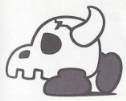Gyātoru: Difference between revisions
From the Super Mario Wiki, the Mario encyclopedia
Jump to navigationJump to search
(Fixed) Tag: Mobile edit |
No edit summary |
||
| Line 5: | Line 5: | ||
|comparable=[[Chikuchiku]]<br>[[Sniper]]<br>[[Sukōpī]] | |comparable=[[Chikuchiku]]<br>[[Sniper]]<br>[[Sukōpī]] | ||
}} | }} | ||
'''Gyātoru''' are [[List of enemies|enemies]] | '''Gyātoru''' are [[List of enemies|enemies]] in the [[Donkey Kong (Game Boy)|Game Boy version]] of ''[[Donkey Kong (game)|Donkey Kong]]''. They are encountered in [[Stage 9-3]] and [[Stage 9-6]] only. Just like the [[Sniper]]s, [[Sukōpī]], and [[Chikuchiku]] encountered earlier on, Gyātoru walk around the environment in circles, walking up walls and on ceilings in the process. In Stage 9-3, the first two Gyātoru walk at a slow speed. If [[Mario]] touches them, he loses a [[Extra life|life]]. | ||
==Profiles and statistics== | ==Profiles and statistics== | ||
===''[[Perfect Ban Mario Character Daijiten]]''=== | ===''[[Perfect Ban Mario Character Daijiten]]''=== | ||
{{PEGMCE profile | |||
|name=ギャートル (JP) / Gyātoru (EN) | |||
|artwork=[[File:Gyatoru Artwork.png]] | |||
|shuzoku=ゴースト族 | |||
'''<big>壁づたいの接近に注意</big></b><br> | |seikaku=慎重 | ||
壁にそって歩き回っているギャートル。気がつかないうちに、すぐ後ろにいて驚くこともしばしば。上に乗っても、横から触れられてもダメージを受けてしまう困りものだ。<ref name=Daijiten>「パーフェクト版 マリオキャラクター大事典」 (''Perfect Ban Mario Character Daijiten'') | |tojo_gemu=GBドンキー | ||
|desc='''<big>壁づたいの接近に注意</big></b><br> | |||
壁にそって歩き回っているギャートル。気がつかないうちに、すぐ後ろにいて驚くこともしばしば。上に乗っても、横から触れられてもダメージを受けてしまう困りものだ。<ref name=Daijiten>{{cite|language=ja|date=1994|publisher=[[Shogakukan]]|title=「パーフェクト版 マリオキャラクター大事典」 (''Perfect Ban Mario Character Daijiten'')|page=[https://i.imgur.com/0FBmeSV.jpeg 61]}}</ref> | |||
|tribe=Ghost clan | |||
|disposition=Cautious | |||
|game_appearances=GB Donkey | |||
'''''<big>Be careful approaching by the wall</big>'''''<br> | |eng_desc='''''<big>Be careful approaching by the wall</big>'''''<br> | ||
''Gyātoru walks around along the walls. Often, before you know it, they are right behind you, surprising you. They are a pain to get on top of, and even if you touch them from the side, they can still damage you.'' | ''Gyātoru walks around along the walls. Often, before you know it, they are right behind you, surprising you. They are a pain to get on top of, and even if you touch them from the side, they can still damage you.'' | ||
}} | |||
==Gallery== | ==Gallery== | ||
<gallery> | <gallery> | ||
DKGB Skullmask.png|Sprite | DKGB Skullmask.png|Sprite from ''Donkey Kong'' (Game Boy) | ||
</gallery> | </gallery> | ||
Revision as of 09:02, July 8, 2024
The title of this article is official, but it comes from a non-English source.
If an acceptable English name is found, then the article should be moved to the new title.
| Gyātoru | |||
|---|---|---|---|
 Artwork of a Gyātoru from Perfect Ban Mario Character Daijiten | |||
| First appearance | Donkey Kong (Game Boy) (1994) | ||
| |||
Gyātoru are enemies in the Game Boy version of Donkey Kong. They are encountered in Stage 9-3 and Stage 9-6 only. Just like the Snipers, Sukōpī, and Chikuchiku encountered earlier on, Gyātoru walk around the environment in circles, walking up walls and on ceilings in the process. In Stage 9-3, the first two Gyātoru walk at a slow speed. If Mario touches them, he loses a life.
Profiles and statistics
Perfect Ban Mario Character Daijiten
Gallery
Names in other languages
| Language | Name | Meaning | Notes |
|---|
References
| Donkey Kong | |
|---|---|
| Characters | Donkey Kong • Mario • Pauline |
| Levels | 25m • 50m • 75m • 100m |
| Items and objects | Bolt • Conveyor Belt • Girder • Hammer • Ladder • Lift • Parasol, Hat & Bag |
| Enemies and obstacles | Barrel • Cement tub • Fire • Fireball • Jack • Oil drum |
| Music | Opening • 25m Theme • Hammer |
| Other | Gallery • Media • Staff |
